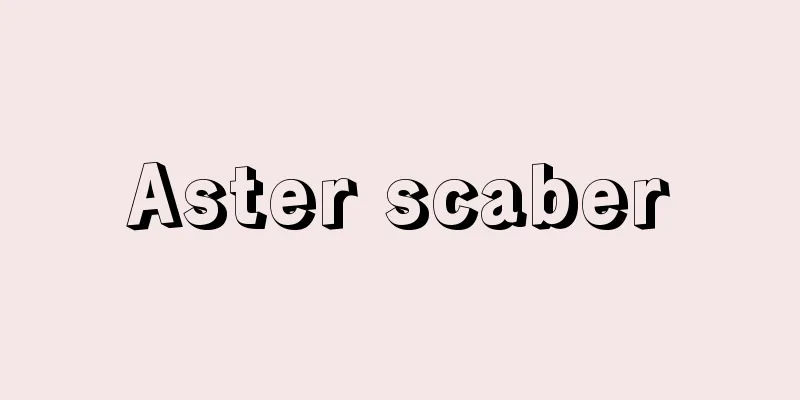Waterworks - waterworks

|
The total number of urban facilities that supply drinkable water for daily life through pipes to areas where people live. Administratively, there are distinctions based on the size and target of the water supply, such as water supply systems (for a planned population of 5,001 or more), simple water supply systems (for a planned population of 5,000 or less), private water supply systems (for supplying water only to company housing, etc.), water supply businesses (wholesale to waterworks companies), agricultural water supply systems, etc., but here we will exclude industrial water supply systems and general service water supply systems and refer to all systems that distribute drinkable water as water supply systems. [Miki Kobayashi] History of the WaterworksThe origin of waterworks is when people jointly set up facilities to bring fresh water close to settlements when, for some reason, it was not possible to live near natural clear streams, springs, or wells, or when the population of a settlement grew so large that pollution could not be avoided or there was a shortage of water. In the cities of the ancient Mesopotamian civilization, there are remains of underground waterways that brought water to wells within the city. In the cities of the ancient Roman Empire, aqueducts were built to take water from clear streams and springs in highlands tens of kilometers away and bring it to the city. In Japan, irrigation canals have existed since the Yayoi period, and clean water was also used for daily life. However, from the Sengoku period to the early Edo period, waterworks began when castle irrigation water was diverted to castle towns. It was only after society stabilized in the Edo period that waterworks began to be distributed finely within urban areas. In Edo, in particular, the construction of urban areas on reclaimed land necessitated the need to artificially convey good quality drinking water, and waterworks were developed vigorously from the Kanda Aqueduct in 1590 (Tensho 18) to the Tamagawa Aqueduct in 1654 (Shoo 3). Waterworks were also installed in over 40 castle towns of various feudal domains to ensure water for daily life and fire prevention in response to population increases. Although wooden pipes were used within urban areas, these waterworks continued to be used from the end of the Meiji period until the modern waterworks were laid in the Taisho period. The commonality between the water systems of ancient Rome and those of early modern Japanese cities is that they conveyed fresh water from distant springs and rivers and supplied it as is, without any treatment, and that all water was guided along a natural gradient from the distant water source to the end. Therefore, the pipes within urban areas were generally unpressurized, and water was allowed to flow continuously through manholes (called drinking water wells, from which people drew water for use), with surplus water being dumped into the river. In ancient Rome, surplus water was allowed to overflow into baths and fountains. In the 18th century, European cities experienced a rapid population growth following the Industrial Revolution, and suffered from the spread of infectious gastrointestinal diseases such as cholera, typhoid fever, and dysentery. Empirical evidence showed that in areas where safe well water was unavailable and river water was distributed, there were fewer cases of disease in areas where river water was supplied after being filtered through sand, and sand filter ponds were built in the second half of the 19th century. This was several decades before Koch and others discovered pathogens. Filtered water also began to be distributed through iron pipes to prevent it from becoming contaminated. Around the same time, pumps, valves, and iron pipes were put to practical use, and a new type of water supply system that distributed filtered water under pressure to prevent it from becoming contaminated on the way gradually became more widespread. In Japan, cholera and dysentery became epidemic every year, mainly in open ports, and tens of thousands to hundreds of thousands of people died each year. Although it was known that a new Western-style water supply system was needed, construction was delayed due to lack of funds. It was only after 1887 (Meiji 20) that "modern water supply systems" were established in Yokohama, Hakodate, Nagasaki, Osaka, Hiroshima, etc., although on a small scale, by filtering river water through sand and distributing it through pressurized iron pipes. Initially, all materials, including iron pipes and valves, were purchased from England. Modern water supply systems were established in 24 cities during the Meiji period, and in 39 more cities during the Taisho period. It was around 1935 (Showa 10) that water supply was distributed to the centers of major cities in Japan, and the water supply coverage rate was 25% in 1952 (Showa 27). However, in the 1960s and 1970s, the rate was rapidly improved due to economic growth, and reached 96.4% in 2000 (Heisei 12). Approximately 4.57 million people live in areas without water supply. [Miki Kobayashi] How the water worksA water supply system consists of facilities that collect and take in the necessary water (water source facilities, water intake facilities), facilities that transport the water to the demand area (water conveyance facilities, water supply facilities), facilities that improve the quality of the water and treat it so that it is drinkable (water purification facilities), facilities that transport the water with the necessary water pressure and volume within the city and distribute it to the consumers' homes (water distribution facilities), facilities that lay pipes to the taps within the consumers' premises and buildings (water supply equipment), and a function that monitors and operates the entire system in terms of water volume, water pressure, and water quality (central management function). The two important elements of a water supply system are the continuity of water volume (enough water can be drawn from the tap at any time) and good water quality (no health-damaging substances, color, turbidity, or unpleasant odors and tastes). A water supply system that always has an abundant supply of high-quality water is ideal, but even developed countries face various difficult challenges. Water supply systems require huge capital investment, so they are built and operated by public corporations in each city. However, municipal management is not always effective in terms of facility operation, maintenance, and fee collection, and there is a trend worldwide toward partial privatization and outsourcing. In any case, the costs are covered by fees paid by water users. [Miki Kobayashi] Water supply volumeThe amount of water taken in by the human body through food and drink is about 3 liters per person per day, but when cooking, washing, bathing, washing, cleaning, and other daily uses are considered, 100 to 200 liters of water is used per person per day. This amount varies depending on the number of people living in the same household and the frequency of bathing, washing, and eating out. In an entire city, water consumption is added up for hospitals, hotels, restaurants, transportation, schools, etc., so if the total water supply is divided by the population served (registered resident population), it is equivalent to 200 to 400 liters per person per day. This amount varies depending on the size and characteristics of the city, and the more central a city is, the higher the value will generally be. Also, during emergency evacuation following an earthquake disaster, 3 liters per person may be enough for a few days, but after several days, laundry and bathing will be necessary, so several tens of liters will be needed. [Miki Kobayashi] Water SourceIn Japan, groundwater is the source of only 30% of the total water supply, and 70% of the raw water for water supply is surface water (water from rivers and lakes), mainly in large cities. Groundwater is superior in terms of stable water quality and volume, but when the demand for water supply exceeds the amount of water that can be pumped without causing problems such as land subsidence, it becomes necessary to rely on surface water. In many cases, the natural flow of rivers has been used for agriculture since ancient times, so the only way to newly draw water is to build a dam upstream and adjust heavy rainfall. In order to secure water volume even in a dry year that is the first in decades, a large reservoir that can be stored for years is required, but in Japan's topography, it is impossible to build a large dam without relocating rural villages and affecting the environment, so there are natural limitations. On the other hand, it is possible to draw large volumes of water from the downstream of large rivers, but this is because agricultural runoff and sewage collect there, so advanced water purification treatment is required and the water is not necessarily delicious. As such, it is difficult to balance the quality and quantity of water at the source, and this presents major problems for water supply systems in large urban areas. [Miki Kobayashi] Water PurificationWater purification is the process of processing raw water taken from a water source to a quality that is safe to drink, and the facility that carries this out is called a water purification plant. The process of water purification consists of removing unsuitable components in the raw water (turbidity, color, pathogenic microorganisms, pollutants, heavy metals, unpleasant odors, tastes, etc.) and adding chlorine for sterilization. Therefore, the treatment is simple enough to ensure clear raw water, and water is supplied only with chlorine sterilization only when good groundwater is available. Even in the case of surface water, if the catchment area of the water source is covered with forests and there is little overall risk, the safety of drinking water can be ensured by removing turbidity and sterilization alone. However, if there are leisure facilities such as golf courses, lakes, mines, farmland, urban settlements, factories, waste disposal sites, etc. upstream, in addition to removing turbidity, thorough removal of sewage organic matter, microorganisms, heavy metals, pesticides, unpleasant odors, tastes, etc. is often required. Looking at the history of water purification technology, attempts to obtain water similar to groundwater for urban water supply by creating a vast sand layer and slowly permeating river water began in London in the 1820s. The sand layer not only physically holds back suspended solids in the water, but also comprehensively removes bacteria, iron, manganese, unpleasant odors and tastes, ammonia, etc., through a biofilm (filter membrane) consisting of algae plankton and protozoa that grow on the surface of the sand layer, and this method spread as an excellent water purification method and became established as the "slow sand filtration method." Japan learned this method from the UK, and all modern water purification plants built in various cities, starting with Yokohama in 1887 (Meiji 20), used this slow sand filtration method for purification until the 1930s (with the exception of a few exceptional places). However, this method became unsuitable for Japan's large cities in the second half of the 20th century because it required a vast amount of land to filter 30,000 cubic meters of water a day to supply a population of 100,000, requiring a filtration basin of 10,000 square meters and a sedimentation basin of roughly the same size to filter 30,000 cubic meters of water a day to supply water to a population of 100,000, and because pouring in turbid raw water during floods would clog the sand layer and reduce the amount of water that could pass through. Nishi-Shinjuku, where high-rise buildings such as the Tokyo Metropolitan Government Building stand, is the former site of the vast sand filtration basins of the Yodobashi Water Purification Plant. Currently, the "rapid filtration method" described below has become mainstream because it requires a smaller amount of land, can handle high turbidity and a certain level of pollution, and requires less labor. The rapid filtration method is characterized by the fact that it destabilizes micrometer-sized substances such as clay, organic colloids, and bacteria in the raw water by adding a positively charged coagulant (aluminum is widely used) to absorb and capture them into flocs (such as aluminum hydroxide), allowing them to grow to millimeter-sized substances, and then efficiently separates suspended matter through sedimentation and sand filtration. It is 30 to 50 times more efficient per site area than the slow filtration method, but since it is not completely effective at removing bacteria, it is supplemented by chlorine disinfection. However, for microorganisms and protozoan eggs that are resistant to chlorine disinfection, it is essential to thoroughly remove particulate matter at the coagulation and filtration stages. Also, only a small amount of dissolved contaminants can be expected to be removed secondarily through adsorption, etc., so if their removal is particularly necessary, separate treatment must be added to ensure thorough purification. This is called special treatment, and some of the treatments carried out include oxidation treatment (using ozone or chlorine as oxidants to decompose organic matter and break it down into smaller molecules, oxidize and remove manganese, and decompose ammonia), adsorption treatment (adsorbing and removing odors, tastes, and poisons using activated carbon), and biological oxidation treatment (utilizing the biochemical reactions of microorganisms to nitrify ammonia and remove odors, tastes, iron, and manganese). Furthermore, when water purification is carried out, the pollutants removed from the raw water, mainly clay substances, remain as sludge, which must be disposed of in a way that does not pollute the external environment. Generally, it is solidified by processes such as thickening, dehydration and drying, and then used or disposed of as landfill soil or soil improvement material for farmland, raw material for ceramics such as cement manufacturing, topsoil for creating athletic fields, etc. During this process, freeze-thaw methods, aluminum recovery methods, polymer coagulation methods, etc. are used to improve the quality of sludge that is difficult to thicken and dehydrate, and solar drying is generally used for dehydration, but in urban areas where it is difficult to obtain large enough land, methods such as heating, electro-osmosis and high-pressure compression dehydration have been developed and are used. [Miki Kobayashi] Water DistributionThe process of distributing purified water at a water purification plant to the narrow streets of residential areas (public areas) is called water distribution. When a consumer opens a tap or a fire hydrant is opened in the event of a fire, the water pressure, storage of water volume, and water flow capacity are necessary to instantly provide the required amount of water. A water distribution facility consists of a water reservoir, a water distribution pump and water distribution pipes, and a function to control water pressure and water volume, and these facilities function by being properly located and operated. First, a water reservoir that can store 30 to 50% of the water used in a day is installed on a small hill near the water supply area, and it receives water directly delivered from the water purification plant. The role of the water reservoir is to adjust the time fluctuation of water demand, which is concentrated in the morning and evening, and to send out water stored at night when demand is low during peak hours. In residential areas, it supplies water in the morning on sunny days when laundry is concentrated, and in small cities, it also supplies water during fires. If the water distribution capacity is insufficient, there will be areas where water is poorly supplied during peak hours. After the water reservoir, water is delivered to each block through water distribution pipes buried under public roads. Within the water supply area, water is supplied directly from the water level of the distribution reservoir. In addition, when the elevation difference in the urban area is large, the water supply area is divided according to the ground level, and water is supplied to the high-rise area by installing a distribution reservoir at an even higher elevation or through a booster pump, while water is supplied to the low-rise area by reducing the water pressure. Furthermore, in order to average the water pressure, water distribution pipes are arranged in a ring or mesh pattern within the urban area, and tree-shaped or dead-end arrangements are avoided as much as possible. This is particularly important for ensuring the amount of water to be used for firefighting and for ensuring the water supply in the event of a disaster or accident. Furthermore, in times of high water usage, the water pressure at the faucet drops due to frictional resistance within the distribution pipe, and conversely, the water pressure becomes too high at night. In order to alleviate the time-based fluctuations in water pressure due to water usage, the water pressure in the water main is constantly adjusted by pumps and valves. [Miki Kobayashi] Water supply equipmentThe part that branches off from the water pipes under the public road and reaches the consumer's faucet is called the water supply system. The water supply system in a private building is privately owned except for the meter (a water measuring device used to charge fees), but the waterworks bureau sets standards for the shape and material of pipes that are directly connected to the water supply system to prevent water pollution accidents. The amount of water used is read as the cumulative number of revolutions of the impeller inside the meter, either visually or by converting it into an electrical signal, and is the basis for calculating water charges. In principle, water is used by discharging it from the faucet, but since flush toilets require water pressure, they are exceptionally allowed to be directly connected to the water pipe, provided that a special valve is installed to ensure that wastewater does not flow back into the water pipe. Other similar devices include hot water heaters, cold water drinking fountains, solar water heaters mounted on the roof, dishwashers, and washing machines. Water pipes are operated at a pressure that allows direct use in ordinary homes of around two stories. In cases where this water pressure is insufficient for high-rise or large buildings, a tank-type water supply system has been made mandatory, whereby tap water is first received in a water tank on the first floor, then pumped to an elevated tank on the roof or elsewhere, and then piped from the tank to the inside of the building to supply water. However, with the increase in mid- to high-rise housing, water quality management on the part of the buildings is not thorough, and there are endless cases of water quality deteriorating inside buildings. As a result, large cities are gradually making improvements to facilities to increase the water supply pressure of water pipes so that water can be supplied directly from the water pipes up to around the 10th floor. Thus, the quality of water at the point of use is not only affected by the conservation of water source areas, and the maintenance and management of water purification plants and distribution facilities, but can also easily be compromised by poor management of piping equipment within buildings. A reliable and healthy water supply system is the property of citizens and indispensable for urban life, so it is necessary to carefully protect it so that it can function stably in terms of water quantity and quality. [Miki Kobayashi] "New System of Civil Engineering, Vol. 88, Water Supply" by Norihito Tanbo (1980, Gihodo Publishing) [Reference items] | | | | | | | | | | |Aqueduct (waterway bridge) from the ancient Roman period. In order to transport water at a natural flow rate, an elevated bridge was built on the lowlands, and the waterway was placed on top of it to cross the valley. Part of the World Heritage Site "Old Town of Segovia and Aqueduct" (Spain, registered in 1985) Segovia, Spain ©Shogakukan "> Segovia Aqueduct ©Shogakukan "> How the water supply works (the water purification process) Source: Shogakukan Encyclopedia Nipponica About Encyclopedia Nipponica Information | Legend |
|
生活用水として飲用可能な水を人々の集住する地域に管で供給する都市施設の総体。行政上は規模や給水対象により上水道(計画給水人口5001人以上)、簡易水道(同5000人以下)、専用水道(社宅などだけへの給水)、用水供給事業(水道事業体への卸売り)、営農水道ほかの区別があるが、ここでは、工業用水道や雑用水道は除外して、飲用可能な水を配るシステムを総称して上水道として扱う。 [小林三樹] 水道の歴史自然の清流や湧泉(ゆうせん)もしくは井戸の近くになんらかの理由で居住できない場合や、集落の人口が増えて汚染を避けられないとか水量が不足する場合に、集落の近くまで清水を導く施設を共同で設けたのが水道の起源であり、古代メソポタミア文明の都市にすでに地下水路を通して都市内の水汲(みずく)み井戸まで導水した遺構がある。古代ローマ帝国の諸都市には、数十キロメートルも離れた高地の清流河川や泉から取水して都市まで導く水道(アクエダクト)が築造されていた。 日本では灌漑(かんがい)用水路は弥生(やよい)時代からあり、きれいな用水であれば生活用にも用いていたのだが、戦国時代から江戸時代初期にかけて、城郭用水を城下町にも流したのが水道の始まりである。市街地内に細かく分配されるようになったのは、江戸時代に入って社会が安定してからで、とくに江戸では埋立地に市街地を造成する関係から良質の飲用水を人工的に導水する必要に迫られ、1590年(天正18)の神田(かんだ)上水から1654年(承応3)の玉川上水に至る間に水道の整備が鋭意進められた。諸藩の40余の城下町においても人口増に対処して生活用と防火用の水を確保するために水道が設けられた。市街地内は木管であったが、これらの水道は明治末から大正期に近代水道が敷設されるまで使用され続けた。古代ローマ水道とこれら日本の近世都市の水道との共通点は、遠くの泉や川から清水を導水してそのまま無処理で供給していたこと、遠くの水源から流末まですべてが自然の勾配(こうばい)に沿って導かれたことである。したがって市街地内の管も一般に無圧であり、桝(ます)(上水井戸とよび、人々はここから汲みあげて使った)を通じて常時流れっぱなしであり、余水は川に落とされていた。古代ローマでは余水を浴場や噴水池にあふれさせた。 18世紀に入り産業革命を経て人口の急増したヨーロッパの都市では、コレラ、腸チフス、赤痢など消化器系伝染病の蔓延(まんえん)に悩まされていた。安全な井戸水が得られず、川の水を配っていた地域でも、河川水を砂濾過(ろか)して給水していた地域に患者の発生の少ないことが経験的に知られ、19世紀後半には砂濾過池がつくられるようになった。コッホらが病原菌を発見するより数十年も以前のことであった。また濾過された水は汚染されないように鉄管により配られるようになった。同じころにポンプやバルブや鉄管も実用化され、濾過水が途中で汚染されないように有圧で配る新しい型の水道が徐々に普及していった。 日本では開国直後からコレラや赤痢が開港場を中心に毎年流行し、年に数万から十数万人もの死者を出していた。西洋流の新しい水道が必要と知られながらも資金難からなかなか着工に至れず、1887年(明治20)以降になってようやく小規模ながら横浜、函館(はこだて)、長崎、大阪、広島などに河川水を砂濾過して有圧の鉄管で配る「近代水道」が整備されるに至った。当初は鉄管もバルブもすべての資材をイギリスから購入した。明治年間に24都市、大正年間にさらに39都市に近代水道が設けられた。日本で主要都市の中心部に水道が行き渡ったのは1935年(昭和10)ごろであり、水道普及率は1952年(昭和27)に25%であったものが、経済成長を受けて1960~1970年代に急速に整備され、2000年(平成12)には96.4%まで達した。水道のない地域に住む国民は約457万人である。 [小林三樹] 水道の仕組み水道は、必要な水を集め取り入れる施設(水源施設、取水施設)、需要地までまとめて運ぶ施設(導水施設、送水施設)、水質を改良し飲めるように処理する施設(浄水施設)、必要な水圧と水量とを伴って市街地内を輸送し需要者の地先まで配る施設(配水施設)、需要者の敷地内や建物内を蛇口まで配管する施設(給水装置)、これら全体を水量水圧面と水質面で監視し運用する機能(中央管理機能)からなる。上水道で重要な二つの要素は、水量の継続性(いつでも蛇口から十分な水量を取り出せること)と水質の良好さ(健康を損なう成分や色、濁り、異臭味を含まないこと)にある。いつでも良質な水が潤沢に出る水道は理想であるが、先進国でもさまざまな困難な課題を抱えている。なお水道は巨額の設備投資を必要とする施設なので各都市の公営企業体が建設して運営している。しかし施設運転や保守、料金徴収業務などに市町村営がかならずしも有効とはいえない面もあり、世界的には一部民営化や委託の方向にある。どの場合でもその費用は水道利用者の負担する料金によってまかなわれている。 [小林三樹] 水道の給水量人体が飲食物を通じて摂取する水量は1人1日約3リットルであるが、調理、洗濯、入浴、洗面、清掃ほかの生活用水もあわせて1人1日の生活に100~200リットルの水が使われる。この値は同居人数、入浴や洗濯や外食の頻度などにより異なる。都市全体では病院、ホテル、飲食店、交通機関、学校などの使用量が加わるので、全給水量を給水人口(住民登録人口)で割ると、市民1人1日当り200~400リットルに相当する。この値は都市の規模や性格によって異なり、都市機能の集積した中枢都市ほど一般に大きな値を示す。また地震災害などでの緊急避難時に数日なら1人当り3リットル程度ですんでも、数日を経ると洗濯も入浴も必要になるので数十リットルは必要になる。 [小林三樹] 水源日本では地下水を水源としている水道の水量合計は全体の30%でしかなく、大都市を中心に水道原水の70%を表流水(河川や湖沼の水)に依存している。水質と水量が安定していることでは地下水が優れているが、地盤沈下などの弊害を生ぜずに揚水可能な水量を超えて水道の需要水量が増すと、表流水に依存せざるをえなくなる。河川の自流は古くから農業などに利用されている場合が多いので、新規に取水するには上流にダムを設けて大雨を調節して利用するしかない。何十年ぶりというような少雨年でも水量を確保するには、経年備蓄できるような大きな貯水池を必要とするが、日本の地形では農山村集落の移転や環境への影響なしに大ダムはつくりえず、おのずと限界がある。一方、大河川の下流から取水するほど大水量を取水しうるが、それは農業排水や下水が集まるからで、高度の浄水処理を必要とし、かならずしもおいしい水にはなりにくい。このように水源の水質と水量とが両立しがたいところに、大都市域の水道は大きな問題を抱えている。 [小林三樹] 浄水水源から取水した水(原水)を安心して飲める水質にまで加工することを浄水処理または浄水といい、それを行う施設が浄水場である。浄水処理の過程は、原水中の飲用不適な成分(濁りや色、病原微生物や汚染成分、重金属、異臭味など)を除去することと、殺菌のための塩素添加からなる。したがって清澄な原水を確保できるほど簡単な処理ですむこととなり、良好な地下水を取水できる場合に限り塩素殺菌のみで給水されている。表流水の場合でも、水源の集水域が森林で覆われているなど総合的にみて危険が少ないならば、濁りの除去と殺菌のみで飲用上の安全は確保される。しかし上流にゴルフ場などのレジャー施設、湖沼、鉱山、農地、都市集落、工場、廃棄物処分場などがある場合には、濁りの除去に加えて、さらに下水性有機物、微生物、重金属、農薬、異臭味成分などの徹底した除去を必要とすることが多い。 浄水技術を歴史的にみると、都市給水のため広大な面積の砂層を設けて河川水を緩やかに浸透させ、地下水に類似した水を得ようとする試みは1820年代のロンドンに始まった。砂層では水中の懸濁物が物理的に抑留されるにとどまらず、砂層表面に繁殖する藻類プランクトンや原生動物の群落からなるバイオフィルム(濾過膜)によって細菌、鉄、マンガン、異臭味、アンモニアなどが包括的に除去されることから、優れた浄水方式として広まり「緩速濾過方式」として定着した。日本はこの方式をイギリスから学び、1887年(明治20)の横浜市を初めとして各都市に建設された近代水道の浄水場は、昭和10年代に至るまで(例外的な数か所を除き)すべてこの緩速濾過方式によって浄水処理するものであった。しかし砂層を緩慢な速度で通水させるため広大な敷地面積(人口10万人に給水する1日3万立方メートルの水を漉(こ)すのに、1万平方メートルの濾過池と、さらにほぼ同じ大きさの沈殿池)を必要とすること、洪水時の濁った原水を入れると砂層が詰まってしまい通水量が減少することなどから、20世紀後半の日本の大都市には不向きとなった。東京都庁など高層ビルの建つ西新宿は淀橋(よどばし)浄水場の広大な砂濾過池の跡地である。現在では次に述べる「急速濾過方式」が、狭い用地ですむこと、高濁度やある程度の汚染に対処しうること、労働力が少なくてすむこと、などから主流になっている。 急速濾過方式は、原水中の粘土や有機物のコロイドや細菌などマイクロメートル単位の大きさしかない物質を、プラス荷電をもつ凝集剤(アルミニウムが広く用いられている)を加えて不安定化してフロックfloc(水酸化アルミニウムなど)に吸合捕捉(ほそく)する凝集操作によって、ミリメートル単位の物質まで成長させてから、沈殿ならびに砂濾過による懸濁物分離を能率よく行うことが特徴である。緩速濾過方式に比べて敷地面積当りの効率は30~50倍になるが、細菌除去が不完全なので塩素殺菌で補完する。しかし殺菌用塩素に抵抗力をもつ微生物や原虫卵に対しては、凝集と濾過の段階で粒子状物質を徹底して除去することが肝要である。また溶存汚染物については吸着作用などで副次的に若干の除去が期待されるだけなので、その除去をとくに必要とする場合には個別の処理を別途に付加しなければ浄化が徹底されない。それを特殊処理とよび、酸化処理(オゾンや塩素を酸化剤として有機物の分解や低分子化、マンガンの酸化除去、アンモニアの分解など)、吸着処理(異臭味や毒物を活性炭により吸着除去)、生物酸化処理(微生物の生化学反応を利用したアンモニアの硝化や異臭味、鉄、マンガンの除去)などが一部で実施されている。 なお浄水処理を行うと原水中から除去された粘土物質を主とする汚染物が汚泥(スラッジsludge)として残るので、外部環境を汚染しない方法で始末しなければならない。一般には濃縮、脱水、乾燥などの処理を施して固体化し、埋立て土もしくは農地の土壌改良材、セメント製造など窯業の原料、運動場造成表土などとして利用もしくは処分される。その過程で濃縮脱水しにくいスラッジの改質に凍結融解法、アルミニウム回収法、高分子凝集法などが、また脱水には天日乾燥法が一般的だが、十分な広さの敷地を得にくい都市域では加温や電気浸透や高圧圧搾脱水法などが開発され使用されている。 [小林三樹] 配水浄水場で浄化された水が住宅地の細街路まで配られる過程(公共部分)を配水という。需要者が蛇口を開いたときや火災で消火栓が開かれたときに瞬時に必要な水量が出るためには、適切な水圧、水量の蓄え、水の疎通能力が必要である。配水施設は配水池、配水ポンプと配水管、水圧と水量のコントロール機能からなり、これらの施設が適切に配置され運用されることによってその機能を果たしている。まず給水区域に近い小高い場所に1日使用水量の3~5割の水量を蓄えうる配水池を設け、浄水場から直送される水を受け入れる。配水池の役割は朝夕に集中する給水需要の時間変動の調整にあり、需要の少ない夜間に蓄えた水をピーク時間帯に送り出す。住宅地では洗濯の集中する晴れた日の午前中の供給に、また小都市では火災時の供給にも対処している。配水能力が不足していると、ピーク時間帯に水の出の悪い地域が生ずる。配水池以降は公道下に埋設された配水管を経て各街区に達する。給水区域内には配水池水位からの水圧でそのまま給水される。また市街地の高低差が大きい場合には給水区域を地盤高によって分割し、高区にはさらに高所に配水池を設けるとか増圧ポンプを介して供給し、低区には水圧が過大にならないよう逆に減圧して供給している。さらに水道の配水管は、水圧を平均化するため市街地内に環状もしくは網目状に配置して、樹枝状や行き止まりの配置をなるべく避けている。これは火災時の消火水量確保や災害事故時の給水確保にとくに重要である。なお使用水量の多い時間帯には配水管内の摩擦抵抗のため蛇口での水圧が下がり、逆に夜間には水圧が高くなりすぎるなど使用水量による水圧の時間変動を緩和するために、水道本管の水圧はポンプやバルブで常時調節されている。 [小林三樹] 給水装置公道下の配水管から分岐して需要者の蛇口に至る部分を給水装置という。私有建物内の給水装置はメーター(料金賦課用の量水器)を除き私有物であるが、上水道システムに直接連結して使用している配管には、水質汚染事故の生じないよう、その形状や材質について水道局が規格を定めている。使用水量は、メーター内の羽根車の回転積算数として目視または電気信号に変換して読み取られ、水道料金算定の基礎となる。水は蛇口から放水して用いるのが原則であるが、水洗便器は水圧が必要なことから、汚水が水道管内に絶対に逆流しないような特殊な弁を付けることを条件に、水道管への直結使用が例外的に認められている。ほかに給湯機、冷水水飲み器、屋根にのせる太陽熱温水器、皿洗い機、洗濯機なども同様である。 水道管の水圧は、2階建て程度の一般住宅で直接使用できるよう運用されている。高層や大形の建物などでこの水圧では不足する場合には、1階に受水槽を設けて水道水をいったん受水したのち、屋上などに設けた高置(こうち)水槽にポンプで揚水し、その水槽から建物内部にあらためて配管して給水するタンク式給水方式が義務づけられてきた。しかし中高層住宅が増え、建物側での水質管理が徹底せず、ビル内で水質が悪化する例が後を絶たないため、10階程度までは水道管から直接給水できるように、水道管の配水圧力を高くする施設改良が大都市で順次行われている。 このように使用時点での水質は、水源地域の保全、浄水場、配水施設の維持管理の良否に左右されるのみならず、建物内配管設備の管理不良によっても簡単に損なわれるものである。信頼できる健全な上水道は市民の財産であり都市生活上不可欠であるからこそ、それが水量的、水質的に安定して機能しうるよう大切に守っていく必要がある。 [小林三樹] 『丹保憲仁著『新体系土木工学 第88巻 上水道』(1980・技報堂出版)』 [参照項目] | | | | | | | | | | | |古代ローマ時代の水道橋(水路橋)。水を自然流下の勾配で輸送するため、低地には高架を設け、その上に水路をのせて谷を横断させた。世界文化遺産「セゴビア旧市街と水道橋」の一部(スペイン・1985年登録) スペイン セゴビア©Shogakukan"> セゴビアの水道橋 ©Shogakukan"> 上水道の仕組み(浄水の過程) 出典 小学館 日本大百科全書(ニッポニカ)日本大百科全書(ニッポニカ)について 情報 | 凡例 |
Recommend
Exchange - Irekaeryougae
〘 noun 〙 In the Edo period, the term referred to t...
Simple referral - Kanisouchi
…In response to this, the idea of pre-judicial ...
Yongming Literature (English)
This refers to the literature of the Yongming era ...
Allium monanthum (English spelling) Allium monanthum
… [Mitsuru Hotta]... *Some of the terminology tha...
Cutlet
…A type of meat dish, a corrupted form of the Eng...
Kamo no Agata-nushi
...As he grew older, they held a banquet for seve...
Echo sounder
...However, this method had some drawbacks, such ...
GeV - Geb
One giga electron volt , or 10 9 eV (1 billion ele...
Tulsa - Tarusa (English spelling) Tulsa
An oil and industrial city in the oil fields of n...
Marketing research
It takes various marketing problems as research to...
Ando clan
A powerful clan in the medieval north of Ou. Durin...
Cosmic blackbody radiation
⇒Cosmic background radiation Source: About Shogaku...
Theodor Wiesengrund Adorno
A representative German thinker. He first studied...
Kitzbühel (English spelling)
An old city in Tyrol, western Austria. Population...
Superplasticity
…Under certain conditions, a material can undergo...








![Saijo [town] - Saijo](/upload/images/67cba49a338ae.webp)
